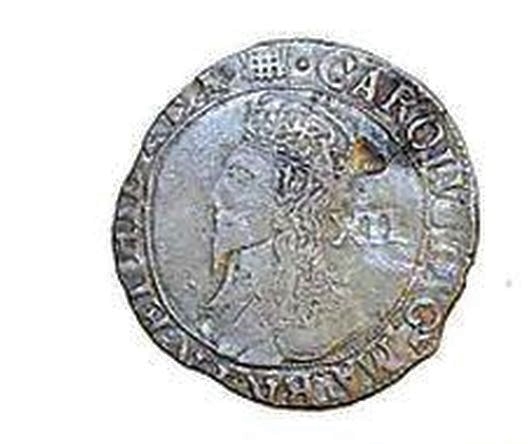American History
Related: About this forumRare 17th-Century Coin Featuring Charles I's Likeness Found in Maryland
In late 2019, archaeologists unearthed the remains of a key landmark in American history: St. Mary’s Fort. A football field–sized plot of land in southern Maryland, the defensive outpost—established by English colonists in 1634—housed the first permanent European settlement in the state and the fourth such settlement in British North America. Historic St. Mary’s City publicly announced the discovery in March 2021 to much fanfare.
Now, Jeffrey R. Parno and his colleagues have once again struck gold—or, more accurately, silver. In late April, archaeologists announced that they’d found a rare silver coin at the fort. The shilling bears inscriptions indicating that it was minted in London between 1633 and 1634, reports Colleen Grablick for DCist. As Michael E. Ruane writes for the Washington Post, the coin’s discovery allows researchers to confidently date the dig site to 1634, the year that English settlers first arrived in Maryland.
When archaeologists first excavated the shilling in November, it felt like “Christmas,” Parno tells DCist. Per the Post, archaeologist crew chief Stephanie Stevens discovered the coin and immediately texted an image of her find to Parno with an elated note: “OMG!” Earlier in the dig, Parno had joked with his team that “if you could find me a coin that has 1634 on it, that would be helpful,” according to a St. Mary’s Fort Instagram post. His team discovered just that.
The coin bears a telltale “mint mark”: a tiny image of a castle portcullis, or a type of closing gate typical in medieval European castles. As Parno tells Live Science, residents of later colonial forts employed tobacco—a valuable cash crop—as currency, so the shilling’s presence site strongly suggests that it was the first European settlement in the region.
https://www.smithsonianmag.com/smart-news/rare-silver-coin-minted-king-charles-is-likeness-discovered-maryland-180977760/

Archaeologists confirmed the discovery of St. Mary's Fort in late 2019 but only announced the news in 2021.
This drawing shows what the the garrison may have looked like.
(Jeffrey R. Parno / Historic St. Mary’s City)

appalachiablue
(42,906 posts)Years ago we visited St. Mary's City and Solomon's Island fairly often.
The excavated small 'tinkling cone' of metal used in trade.

left-of-center2012
(34,195 posts)By the 1600's Native Americans of the Northeast had acquired a wealth of knowledge for working European sheet metals which was no doubt combined with experience in indigenous copper before contact.
A favorite Native American ornament for the past three centuries is a sheet metal trapezoid, rolled into a cone, and attached to knifesheaths, pouches moccasins, or other clothing.
These ornaments are commonly referred to as tinkling cones.
http://www.nativetech.org/metal/tinkle/tinkle.html
Voltaire2
(14,701 posts)left-of-center2012
(34,195 posts)

Voltaire2
(14,701 posts)Charles being the english king who got topped.